
The Great Chicago Fire was a conflagration that burned in the American city of Chicago during October 8–10, 1871. The fire killed approximately 300 people, destroyed roughly 3.3 square miles (9 km2) of the city including over 17,000 structures, and left more than 100,000 residents homeless. The fire began in a neighborhood southwest of the city center. A long period of hot, dry, windy conditions, and the wooden construction prevalent in the city, led to the conflagration spreading quickly. The fire leapt the south branch of the Chicago River and destroyed much of central Chicago and then crossed the main stem of the river, consuming the Near North Side.

The Palace of Westminster, the medieval royal palace used as the home of the British parliament, was largely destroyed by fire on 16 October 1834. The blaze was caused by the burning of small wooden tally sticks which had been used as part of the accounting procedures of the Exchequer until 1826. The sticks were disposed of carelessly in the two furnaces under the House of Lords, which caused a chimney fire in the two flues that ran under the floor of the Lords' chamber and up through the walls.

The Worshipful Company of Barbers is one of the livery companies of the City of London, and ranks 17th in precedence.
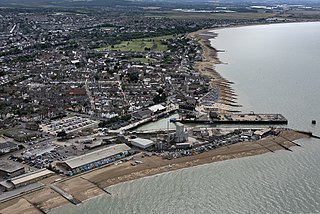
Whitstable is a town on the north coast of Kent, England, at the convergence of the Swale and the Greater Thames Estuary, five miles north of Canterbury and two miles west of Herne Bay.

The Great Boston Fire of 1872 was Boston's largest fire, and still ranks as one of the most costly fire-related property losses in American history. The conflagration began at 7:20 p.m. on Saturday, November 9, 1872, in the basement of a commercial warehouse at 83–87 Summer Street. The fire was finally contained 12 hours later, after it had consumed about 65 acres (26 ha) of Boston's downtown, 776 buildings and much of the financial district, and caused $73.5 million in damage. The destruction to the buildings was valued at $13.5 million and the personal property loss was valued at $60 million. At least 30 people died, including 12 firefighters.

Canterbury, also known as the City of Canterbury, is a local government district with city status in Kent, England. It is named after its largest settlement, Canterbury, where the council is based. The district also includes the towns of Fordwich, Herne Bay and Whitstable, along with numerous villages and surrounding rural areas. Parts of the district lie within the designated Area of Outstanding Natural Beauty of the Kent Downs.

The Great storm of 1703 was a destructive extratropical cyclone that struck central and southern England on 26 November 1703. High winds caused 2,000 chimney stacks to collapse in London and damaged the New Forest, which lost 4,000 oaks. Ships were blown hundreds of miles off-course, and over 1,000 sea men died on the Goodwin Sands alone. News bulletins of casualties and damage were sold all over England – a novelty at that time. The Church of England declared that the storm was God's vengeance for the sins of the nation. Daniel Defoe thought it was a divine punishment for poor performance against Catholic armies in the War of the Spanish Succession.
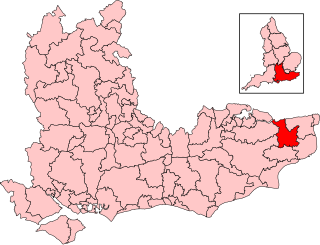
Canterbury is a constituency in Kent represented in the House of Commons of the UK Parliament since 2017 by Rosie Duffield formerly of the Labour Party and since September 2024 an Independent.
The Red Mile is the name given to a stretch of 17 Avenue SW in Calgary, Alberta, Canada during the Calgary Flames 2004 Stanley Cup playoff run, which ended with a loss to the Tampa Bay Lightning in seven games in the finals. It gained worldwide notoriety both for the relative lack of violence while upwards of 55,000 fans celebrated their team's success. The 'Red' originates from the home team colour of the Calgary Flames' jerseys, red, similarly characterized by the 'Sea of Red' seen at many home games in the Saddledome; 'Sea of Red' and 'C of Red' is a play on words.
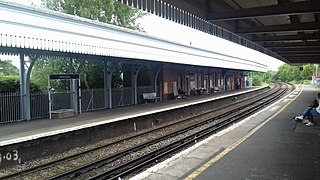
Whitstable railway station is on the Ramsgate branch of the Chatham Main Line in England, serving the town of Whitstable, Kent. It is 59 miles 6 chains (95.1 km) down the line from London Victoria and is situated between Faversham and Chestfield & Swalecliffe.

Chestfield and Swalecliffe railway station is on the Ramsgate branch of the Chatham Main Line in England, serving the villages of Chestfield, Swalecliffe and the Eastern region of the town of Whitstable, Kent. It is 60 miles 45 chains (97.5 km) down the line from London Victoria and is situated between Whitstable and Herne Bay.
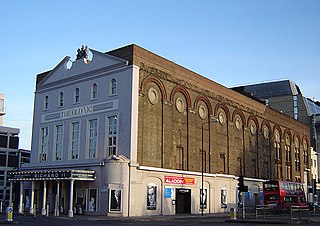
The Cut is a street in London which runs between Waterloo Road in Lambeth and Blackfriars Road in Southwark, approximately parallel to the South Eastern Railway. The Old Vic theatre is at the western (Lambeth) end, and the more experimental Young Vic theatre halfway along on the other side. Lewisham Southwark College is sited on the south side of the Cut and at the eastern (Southwark) end is Southwark Underground station. Waterloo and Waterloo East stations are also nearby.
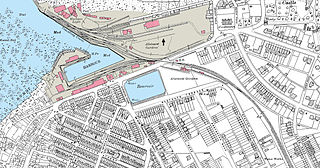
The Canterbury and Whitstable Railway, sometimes referred to colloquially as the "Crab and Winkle Line", was an early British railway that opened in 1830 between Canterbury and Whitstable in the county of Kent, England.

The great fire of Gateshead and Newcastle was a tragic and spectacular series of events starting on Friday 6 October 1854, in which a substantial amount of property in two North East England towns was destroyed in a series of fires and an explosion which killed 53 and injured hundreds. There is only one building still extant on the Newcastle Quayside which predated the fire.

The Great Fire of London was a major conflagration that swept through central London from Sunday 2 September to Thursday 6 September 1666, gutting the medieval City of London inside the old Roman city wall, while also extending past the wall to the west. The death toll is generally thought to have been relatively small, although some historians have challenged this belief.
Margate was a "limb" of Dover in the ancient confederation of the Cinque ports. It was added to the confederation in the 15th century.

John Deane, with his brother Charles, invented the diving helmet and performed diving operations at the wreck of the Mary Rose. They received their education at The Royal Hospital School, Greenwich and were both in attendance in 1812. When he was 14, John joined the East India Company and sailed for seven years.

Bathurst Basin is a small triangular basin adjoining the main harbour of the city of Bristol, England. The basin takes its name from Charles Bathurst, who was a Bristol MP in the early 19th century.
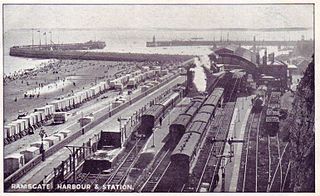
Ramsgate Harbour railway station was a railway station in Ramsgate, in the Thanet district of Kent, England. Opened in 1863 as part of the Kent Coast Railway company's extension of its line from Herne Bay, it was conveniently situated for the seaside resort's beach, but it closed in 1926 after a reorganisation of railway lines in the Thanet area.

Whitstable Museum is a heritage centre in Whitstable, Kent, with Invicta, one of the world's oldest steam engines, the history of the local oyster trade and historical diving equipment.


















